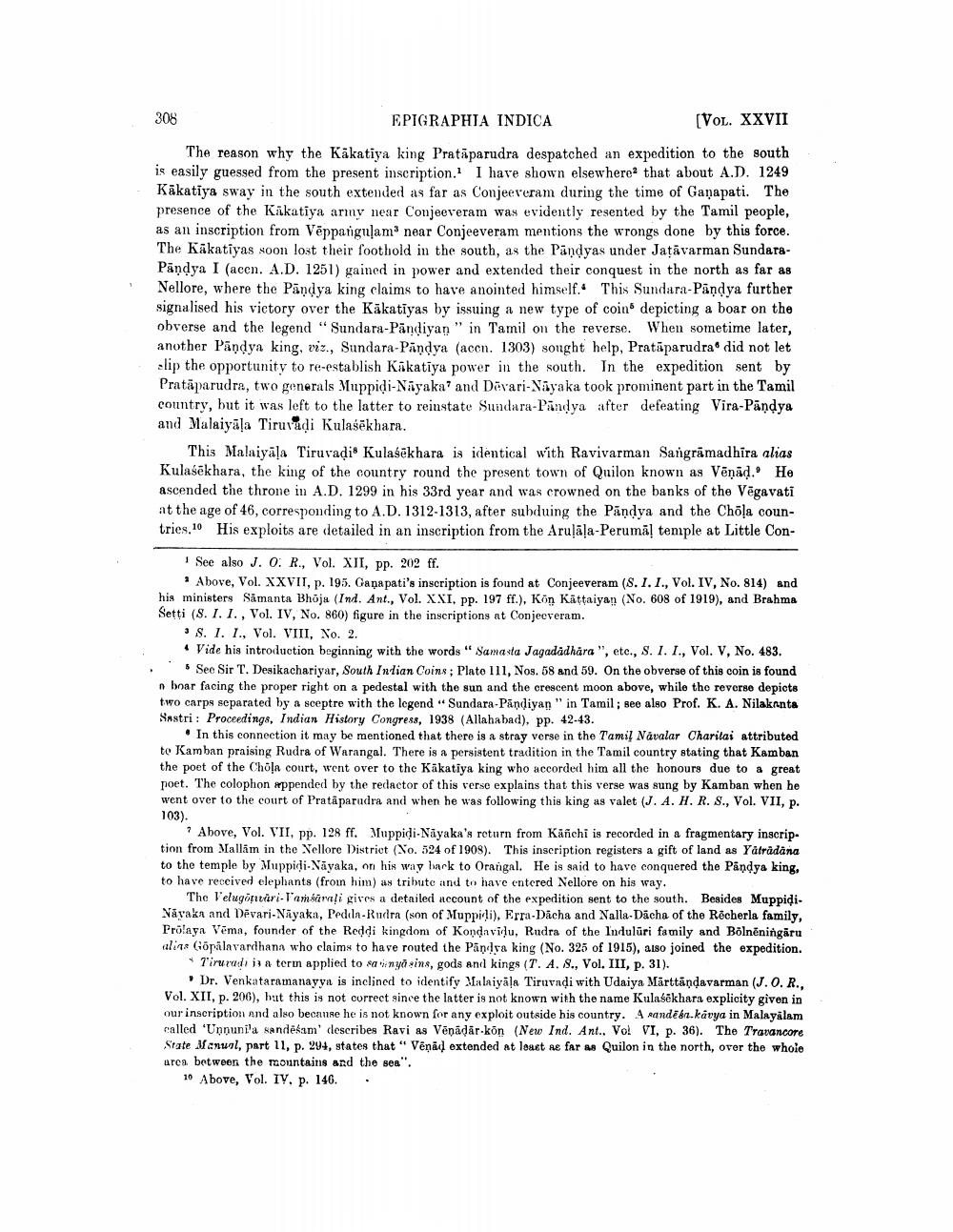________________
308 EPIGRAPHIA INDICA
(VOL. XXVII The reason why the Kakatiya king Pratāparudra despatched an expedition to the south is easily guessed from the present inscription. I have shown elsewhere that about A.D. 1249 Kākatiya sway in the south extended as far as Conjeereram during the time of Ganapati. The presence of the Kakatiya army near Conjeeveram was evidently resented by the Tamil people, as an inscription from Vēppangnlam' near Conjeeveram mentions the wrongs done by this force. The Kakatiyas soon lost their foothold in the south, as the Pandyas under Jațavarman SundaraPandya I (acen. A.D. 1251) gained in power and extended their conquest in the north as far as Nellore, where the Pandya king claims to have anointed himself. This Sundara-Pandya further signalised his victory over the Kakatiyas by issuing a new type of coin depicting a boar on the obverse and the legend "Sundara-Pandiyan" in Tamil on the reverse. When sometime later, another Pandya king, viz., Sundara-Pandya (accn. 1303) sought help, Pratāparudra did not let clip the opportunity to re-establish Kakatiya power in the south. In the expedition sent by Pratāparudra, two generals Muppidi-Nayaka' and Divari-Nayaka took prominent part in the Tamil country, but it was left to the latter to reinstate Sundara-Pandya after defeating Vira-Pandya and Malaiyāla Tiruvadi Kulasēkhara.
This Malaiyala Tiruvadio Kulasekhara is identical with Ravivarman Sangrāmadhira alias Kulasēkhara, the king of the country round the present town of Quilon known as Vēņād. He ascended the throne in A.D. 1299 in his 33rd year and was crowned on the banks of the Vēgavati at the age of 46, corresponding to A.D. 1312-1313, after subduing the Pandya and the Chõļa countries.10 His exploits are detailed in an inscription from the Aruļāļa-Perumal temple at Little Con
See also J. O. R., Vol. XII, pp. 202 ff.
* Above, Vol. XXVII, p. 195. Ganapati's inscription is found at Conjeeveram (S.I. I., Vol. IV, No. 814) and his ministers Samanta Bhoja (Ind. Ant., Vol. XXI, pp. 197 ff.), Kön Kättaiyan (No. 608 of 1919), and Brahma Setti (8. L. I. , Vol. IV, No. 860) figure in the inscriptions at Conjecveram.
• S. 1. I., Vol. VIII, No. 2. Vide his introduction beginning with the words "Samasta Jagadadhara ", etc., S. I. I., Vol. V, No. 483.
Seo Sir T. Desikachariyar, South Indian Coins; Plato 111, Nos. 58 and 59. On the obverse of this coin is found n boar facing the proper right on a pedestal with the sun and the crescent moon above, while the reverse depicts two carps separated by a sceptre with the legend Sundara-Pandiyan " in Tamil; see also Prof. K. A. Nilaknnta Sastri : Proceedings, Indian History Congress, 1938 (Allahabad), pp. 42-43.
In this connection it may be mentioned that there is a stray verse in the Tamil Navalar Charitai attributed to Kamban praising Rudra of Warangal. There is a persistent tradition in the Tamil country stating that Kamban the poet of the Chola court, went over to the Kakatiya king who accorded him all the honours due to a great poet. The colophon appended by the redactor of this verse explains that this verse was sung by Kamban when he went over to the court of Prataparudra and when he was following this king as valet (J. A. H. R. S., Vol. VII, p. 103).
? Above, Vol. VII, pp. 128 ff. Muppidi-Nayaka's return from Kanchi is recorded in a fragmentary inscription from Mallam in the Nellore District (No. 524 of 1908). This inscription registers a gift of land as Yaträdana to the temple by Muppidi.Nayaka, on his way lark to Orangal. He is said to have conquered the Pandya king, to have received elephants (froin him) as tribute and to have entered Nellore on his way.
The VelugonväriTamarali gives a detailed account of the expedition sent to the south. Besides Muppidi. Năvakn and Devari-Nayaka, Pedul-Rudra (son of Muppili), Erra-Dacha and Nalla-Dacha of the Recherla family, Prolayn Vemn, founder of the Reddi kingdom of Konda vidu, Rudra of the Induluri family and Bölněningāru alina Görälavardhana who claims to have routed the Pandra king (No. 325 of 1915), 2180 joined the expedition.
l'irurudi is a term applied to satinya ains, gods and kings (T. A.S., Vol. III, p. 31).
Dr. Venkataramanayyn is inclined to identify Malaivāla Tiruvadi with Udaiya Märttándavarman (J.O.R.. Vol. XII, p. 206), but this is not correct since the latter is not known with the name Kulasekhara explicity given in our inscription and also became he is not known for any exploit outside his country. Anandaba.kavya in Malayalam called 'Unnunila sandekam describes Ravi as Vēnādār-kön (New Ind. Ant. Vol VI, p. 36). The Travancore State Manuel, part 11, p. 294, states that " Vēņād extended at least as far as Quilon in the north, over the whole urca between the mountains and the sea".
10 Above, Vol. IV. p. 146. .




